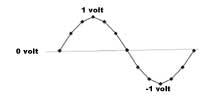Faraday cage
Take one of those small common radios that work with batteries. Turn on the radio, catch a radio signal and start listening to it with the headset. Then pick up the radio with aluminum foil and leave out only the headphone wires. You will soon discover that the radio is no longer heard.
You want to know what the reason is. “Why doesn’t the radio listen now?” The response to the electromagnetic signal issued by the transmitter has been allowed to pass because the aluminum foil does not contain. Aluminium is not obligatory, as the same happens with any good electric conductor. The box that we have built in aluminum is the cage of Faraday.
But –you will tell me– it has no form of cage.
The truth is that it has no form of cage. I propose you another experiment. Make some holes in aluminum foil. Maybe now you think we can pass the radio signal through the holes and listen to it. Listen attentively. Do you hear something? No, right? Electromagnetic radiation does not pass through the holes.

The radio emits electromagnetic waves. Each radio emits waves at a given frequency. For example, AM radios between 560 kHz and 1.100 kHz and FM radios between 88 MHz and 104 MHz. Remember that “k” means one thousand and M a million. When tuning your favorite radio, you choose one of the available frequencies.
The electromagnetic signal is formed by two fields, the electric and the magnetic field. Take for a moment only the electric field. The amplitude (number of volts) of this area is oscillating. That is, it has different values. For example, part of the zero value, rises, reaches 1 volt, low, returns to zero, becomes negative, reaches -1 volts, rises and returns to zero.
This route 010-10 is called cycle or Hertz.
If we say the radio emits at 560 kHz, we are saying that this sinusoid is repeated 560,000 times per second. The radio signal travels at the speed of light. This means it travels in a second 300,000 km. So if we take 300,000 and divide between 560,000, we will have the length (in meters) of a cycle (1 Hz). This length is called wavelength. For 560 kHz the length is 536 meters.
If we take 88 MHz (FM) the same, we will see that only the wavelength is 3.4 meters. Since the hole we have made in our aluminum foil is less than the wavelength, it is impossible for it to pass.
If instead of collecting with aluminum foil we introduce the radio in an iron cage, we pass the same thing and do not hear the radio, since the distance between the iron bars is less than the wavelength.
Thus, with the box made with iron bars connected to the floor, Faraday showed that static electricity does not affect the one inside the cage, hence the name “cage”.
Buletina
Bidali zure helbide elektronikoa eta jaso asteroko buletina zure sarrera-ontzian











